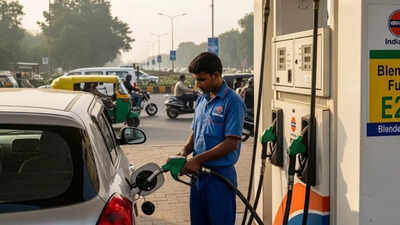ARTICLE AD BOX

India has moved faster than expected in rolling out
E20 petrol
, fuel that contains 20% ethanol blended with 80% petrol. Initially targeted for 2030, E20 is now available nationwide. However, the transition has also stirred unease among motorists worried about
vehicle compatibility
and long-term performance. Here, let’s discuss the benefits, concerns and key things about E20 blending.
Ethanol blending
is not new to India, but scaling it up to 20% offers bigger economic and environmental rewards. Ethanol is largely produced from sugarcane and grains, meaning farmers stand to benefit directly. In fact, in 2025 alone, the government estimates that E20 will bring foreign exchange savings of nearly Rs 43,000 crore and generate close to Rs 40,000 crore in income for farmers.
Volvo EX30 Review: Is the smallest Volvo worth buying? | TOI Auto
From an environmental standpoint, the gains are equally significant. E20 emits less pollutants compared to standard petrol. The Petroleum Ministry claims carbon emissions could fall by up to 30% when compared to E10. For newer E20-compatible vehicles, ethanol’s higher octane might even translate into better performance. The Ministry of Petroleum and Natural Gas has also highlighted ethanol’s advantages, such as higher octane levels (108.5 compared to petrol’s 84.4) that help reduce knocking and improve combustion.
Concerns from motorists
Lately, consumers have raised several concerns around the use of E20 fuel. One of them being dropped
fuel efficiency
. Does it happen? Yes. Ethanol has a lower energy density than petrol, which means engines need to burn more of it to produce the same output. The result is a small but noticeable drop in fuel efficiency: typically 5-7% for most modern cars, though some owners of older vehicles have reported mileage drops of up to 20%.Besides that, in vehicles not designed for higher blends, it can damage rubber seals, and other related parts; however, these aren’t very costly parts. Older BS3 and BS4 models are particularly vulnerable. As for performance, users might also experience a slight drop in performance but it shouldn’t be a concern for newer cars as they are tuned for E20 compatibility. Authorities stress that the rollout is part of India’s clean-energy transition and describe E20 as a “bridge fuel” until electric mobility becomes mainstream.
What drivers should keep in mind
If you own a car made after April 2023, chances are it is already E20-ready. Newer
BS6 Phase 2 models
are largely compatible with the blend. Owners of older cars, however, should check their vehicle manuals or consult manufacturers before filling up with E20. Regular servicing, ethanol-compatible parts, and monitoring performance changes are recommended to minimize issues.



.png)
.png)
.png)
















 20 hours ago
3
20 hours ago
3









 English (US) ·
English (US) ·